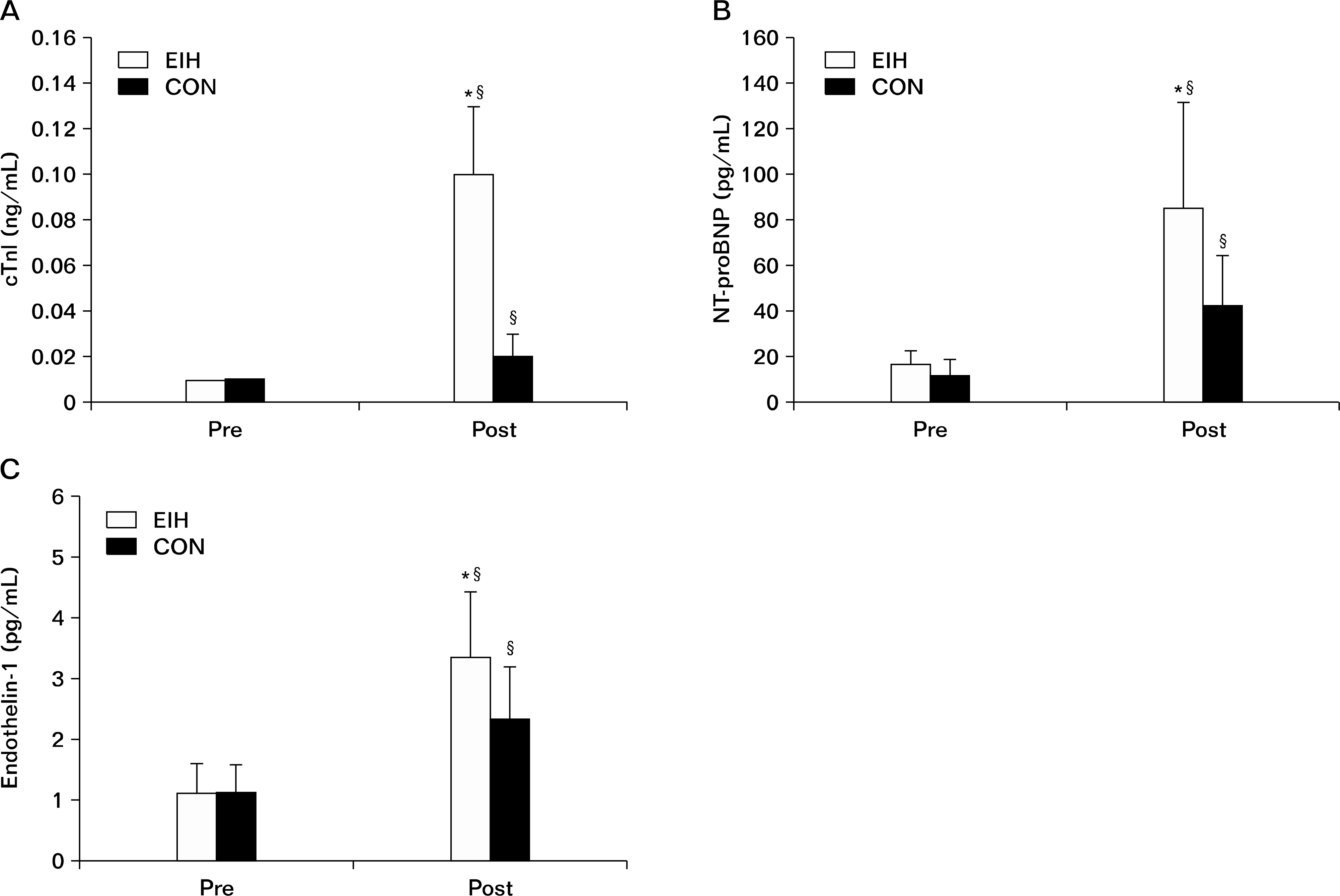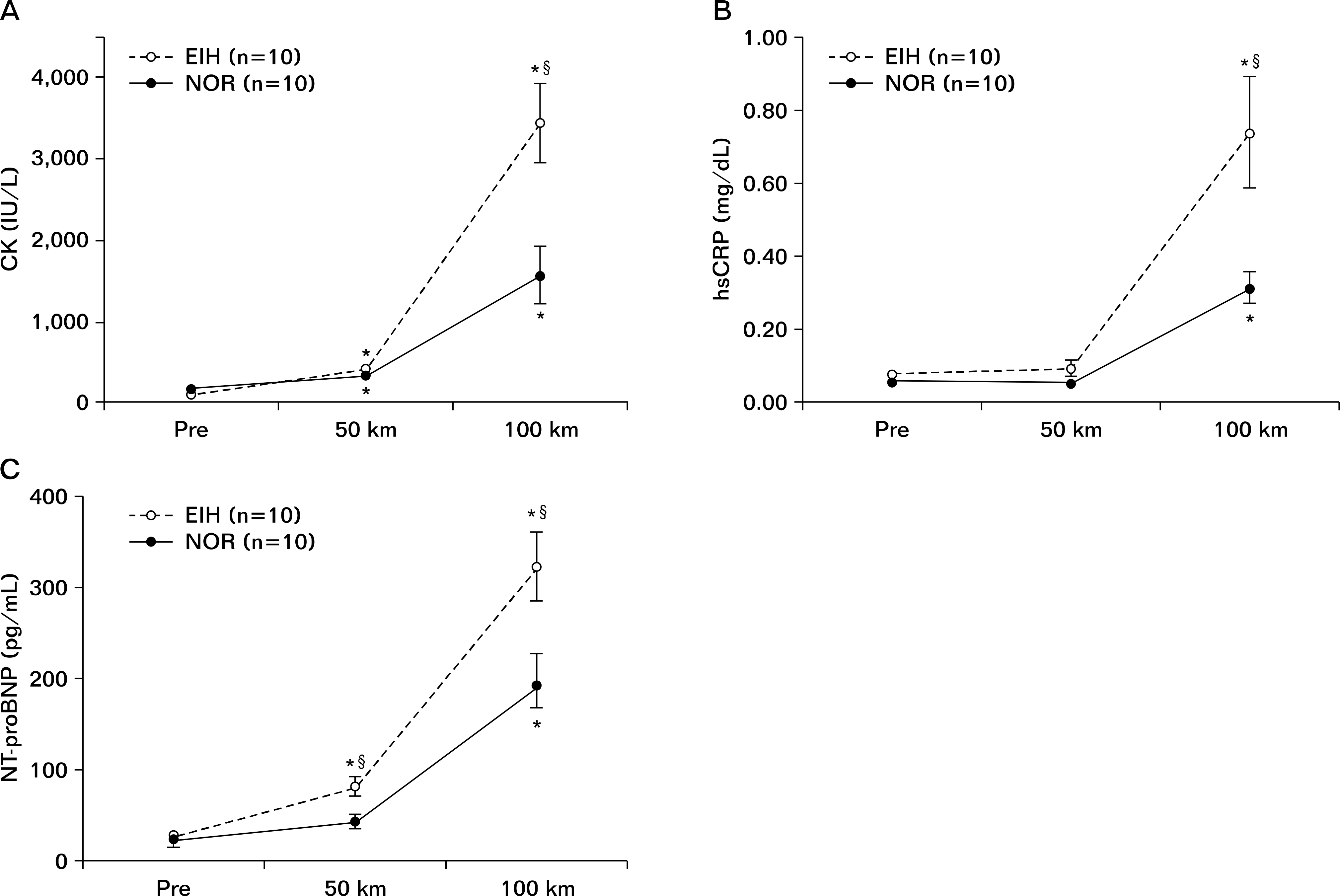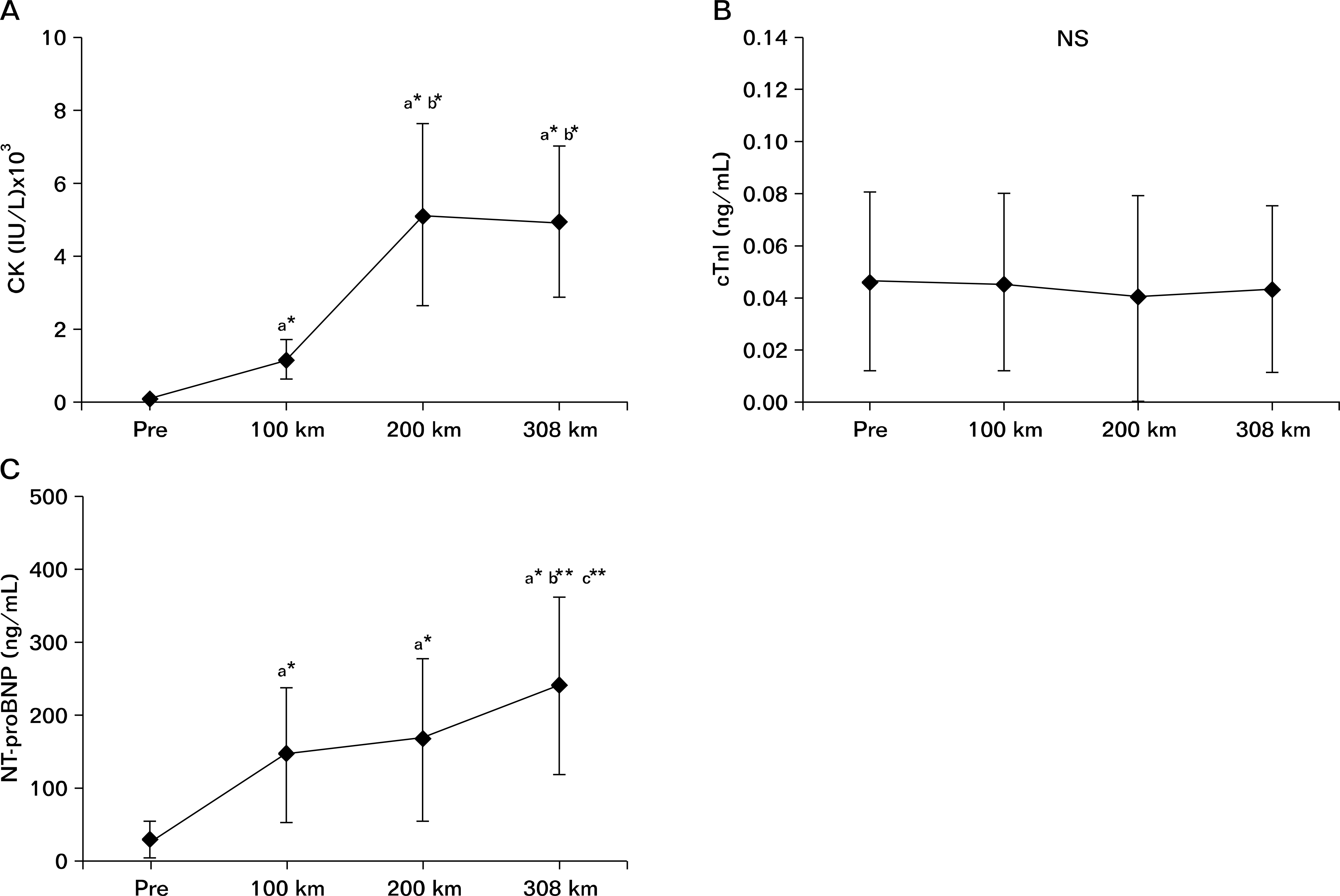Abstract
Regular exercise brings about various positive effects on cardiovascular, oncological, psychiatric, neurological, and endocrinological systems of human body. According to exercise types with cardiovascular adaptation, endurance exercise is characterized by eccentric hypertrophy; resistance exercise is characterized by concentric hypertrophy; and the combination of the eccentric hypertrophy and concentric hypertrophy is seen in cycling and rowing. Although the cardiac functions of athletes are not different from those in general population, athletes show higher exercise capacities because of the increased diameter of ventricle. Atrial fibrillation which is the most common in middle-aged marathoners shows 5.3 times higher prevalence compared to that in general population. In addition, higher arterial stiffness is shown in marathoners, and higher resting blood pressure is shown in sub-3 hours-marathoners. Especially the runners with higher resting blood pressure or severe arrhythmia showed superior cardiopulmonary functions and excessive exercise habits when compared to the normal runners. The runners with exercise-induced hypertension are prone to show increased levels of cardiac markers by increasing cardiac muscle burden in exercise, and then be taken with resting hypertension in the future. The major cause of sudden deaths in marathon race of middle-aged marathoners is coronary artery disease (CAD), and the higher prevalence of CAD is shown in middle-aged marathoners being manifested by the exercise stress test or cardiac computed tomography. Therefore, middle-aged marathoners who regularly participate in marathon race are required to undergo annual exercise stress test, and their additional checkups for cardiovascular system should be supervised by specialized medical doctors.
Go to : 
REFERENCES
1.Mittleman MA., Maclure M., Tofler GH., Sherwood JB., Goldberg RJ., Muller JE. Triggering of acute myocardial infarction by heavy physical exertion: protection against triggering by regular exertion: determinants of Myocardial Infarction Onset Study Investigators. N Engl J Med. 1993. 329:1677–83.
2.Mora S., Cook N., Buring JE., Ridker PM., Lee IM. Physical activity and reduced risk of cardiovascular events: potential mediating mechanisms. Circulation. 2007. 116:2110–8.
3.Dunn AL., Marcus BH., Kampert JB., Garcia ME., Kohl HW 3rd., Blair SN. Reduction in cardiovascular disease risk factors: 6-month results from Project Active. Prev Med. 1997. 26:883–92.
4.Paffenbarger RS Jr., Hyde RT., Wing AL., Lee IM., Jung DL., Kampert JB. The association of changes in physical-activity level and other lifestyle characteristics with mortality among men. N Engl J Med. 1993. 328:538–45.

5.Noakes TD. Heart disease in marathon runners: a review. Med Sci Sports Exerc. 1987. 19:187–94.
6.Kemmler W., von Stengel S., Kohl M. Exercise frequency and bone mineral density development in exercising postmenopausal osteopenic women. Is there a critical dose of exercise for affecting bone? Results of the Erlangen Fitness and Osteoporosis Prevention Study. Bone. 2016. 89:1–6.

7.Laurin D., Verreault R., Lindsay J., MacPherson K., Rockwood K. Physical activity and risk of cognitive impairment and dementia in elderly persons. Arch Neurol. 2001. 58:498–504.

8.Shirayama Y., Chen AC., Nakagawa S., Russell DS., Duman RS. Brain-derived neurotrophic factor produces antidepressant effects in behavioral models of depression. J Neurosci. 2002. 22:3251–61.

9.Lee IM. Physical activity and cancer prevention: data from epidemiologic studies. Med Sci Sports Exerc. 2003. 35:1823–7.
10.Vinereanu D., Florescu N., Sculthorpe N., Tweddel AC., Stephens MR., Fraser AG. Left ventricular long-axis diastolic function is augmented in the hearts of endurance-trained compared with strength-trained athletes. Clin Sci (Lond). 2002. 103:249–57.

11.Pluim BM., Zwinderman AH., van der Laarse A., van der Wall EE. The athlete's heart: a meta-analysis of cardiac structure and function. Circulation. 2000. 101:336–44.
12.Palatini P., Mos L., Di Marco A, et al. Intra-arterial blood pressure recording during sports activities. J Hypertens. 1987. 5:479–84.
13.MacDougall JD., Tuxen D., Sale DG., Moroz JR., Sutton JR. Arterial blood pressure response to heavy resistance exercise. J Appl Physiol. 1985. 58:785–90.

14.Shimizu G., Hirota Y., Kita Y., Kawamura K., Saito T., Gaasch WH. Left ventricular midwall mechanics in systemic arterial hypertension: myocardial function is depressed in pressure-overload hypertrophy. Circulation. 1991. 83:1676–84.

15.Ginzton LE., Conant R., Brizendine M., Laks MM. Effect of long-term high intensity aerobic training on left ventricular volume during maximal upright exercise. J Am Coll Cardiol. 1989. 14:364–71.

16.Fagard RH. Impact of different sports and training on cardiac structure and function. Cardiol Clin. 1997. 15:397–412.

17.Klasnja AV., Jakovljevic DG., Barak OF., Popadic Gacesa JZ., Lukac DD., Grujic NG. Cardiac power output and its response to exercise in athletes and non-athletes. Clin Physiol Funct Imaging. 2013. 33:201–5.

18.Ryder KM., Benjamin EJ. Epidemiology and significance of atrial fibrillation. Am J Cardiol. 1999. 84:131R–138R.

19.Williams PT., Franklin BA. Reduced incidence of cardiac arrhythmias in walkers and runners. PLoS One. 2013. 8:e65302.

20.Mont L., Elosua R., Brugada J. Endurance sport practice as a risk factor for atrial fibrillation and atrial flutter. Europace. 2009. 11:11–7.

22.Calvo N., Brugada J., Sitges M., Mont L. Atrial fibrillation and atrial flutter in athletes. Br J Sports Med. 2012. 46(Suppl 1):i37–43.

23.Abdulla J., Nielsen JR. Is the risk of atrial fibrillation higher in athletes than in the general population? A systematic review and meta-analysis. Europace. 2009. 11:1156–9.

24.Karjalainen J., Kujala UM., Kaprio J., Sarna S., Viitasalo M. Lone atrial fibrillation in vigorously exercising middle aged men: case-control study. BMJ. 1998. 316:1784–5.

25.Pelliccia A., Maron BJ., Di Paolo FM, et al. Prevalence and clinical significance of left atrial remodeling in competitive athletes. J Am Coll Cardiol. 2005. 46:690–6.

26.Baldesberger S., Bauersfeld U., Candinas R, et al. Sinus node disease and arrhythmias in the long-term follow-up of former professional cyclists. Eur Heart J. 2008. 29:71–8.

27.Coumel P. Paroxysmal atrial fibrillation: a disorder of autonomic tone? Eur Heart J. 1994. 15(Suppl A):9–16.

28.Burstein B., Nattel S. Atrial fibrosis: mechanisms and clinical relevance in atrial fibrillation. J Am Coll Cardiol. 2008. 51:802–9.

29.Mont L., Tamborero D., Elosua R, et al. Physical activity, height, and left atrial size are independent risk factors for lone atrial fibrillation in middle-aged healthy individuals. Europace. 2008. 10:15–20.

30.Kim YJ., Kim CH., Park KM. Excessive exercise habits of runners as new signs of hypertension and arrhythmia. Int J Cardiol. 2016. 217:80–4.

31.Haskell WL., Lee IM., Pate RR, et al. Physical activity and public health: updated recommendation for adults from the American College of Sports Medicine and the American Heart Association. Circulation. 2007. 116:1081–93.
32.Agabiti-Rosei E., Mancia G., O'Rourke MF, et al. Central blood pressure measurements and antihypertensive therapy: a consensus document. Hypertension. 2007. 50:154–60.
33.Otsuki T., Maeda S., Iemitsu M, et al. Relationship between arterial stiffness and athletic training programs in young adult men. Am J Hypertens. 2007. 20:967–73.

34.Bertovic DA., Waddell TK., Gatzka CD., Cameron JD., Dart AM., Kingwell BA. Muscular strength training is associated with low arterial compliance and high pulse pressure. Hypertension. 1999. 33:1385–91.

35.Vlachopoulos C., Kardara D., Anastasakis A, et al. Arterial stiffness and wave reflections in marathon runners. Am J Hypertens. 2010. 23:974–9.

36.Boutouyrie P., Lacolley P., Girerd X., Beck L., Safar M., Laurent S. Sympathetic activation decreases medium-sized arterial compliance in humans. Am J Physiol. 1994. 267(4 Pt 2):H1368–76.

37.Fagard RH., Tipton CM. Physical activity, fitness, and hypertension. Bouchard C, Shephard RJ, Stephens T, editors. editors.Physical activity, fitness, and health. Champaign (IL): Human Kinetics;1994. p. 633–55.
38.Lee YH., Kim YJ. Cardiopulmonary fitness factors, homodynamic responses, and cardiac events of the middle aged marathon runners according to the completion distance. Exerc Sci. 2012. 21:121–30.
39.Choi KM., Park HS., Han JH, et al. Prevalence of prehypertension and hypertension in a Korean population: Korean National Health and Nutrition Survey 2001. J Hypertens. 2006. 24:1515–21.

40.Maron BJ., Poliac LC., Roberts WO. Risk for sudden cardiac death associated with marathon running. J Am Coll Cardiol. 1996. 28:428–31.

41.Scharhag J., George K., Shave R., Urhausen A., Kindermann W. Exercise-associated increases in cardiac biomarkers. Med Sci Sports Exerc. 2008. 40:1408–15.

42.Thygesen K., Alpert JS., White HD. Joint ESC/ACCF/AHA/WHF Task Force for the Redefinition of Myocardial Infarction. Universal definition of the myocardial infarction. Kardiol Pol. 2008. 66:47–62.
43.Richards AM., Nicholls MG., Yandle TG, et al. Plasma N-terminal pro-brain natriuretic peptide and adrenomedullin: new neurohormonal predictors of left ventricular function and prognosis after myocardial infarction. Circulation. 1998. 97:1921–9.
44.Fortescue EB., Shin AY., Greenes DS, et al. Cardiac troponin increases among runners in the Boston Marathon. Ann Emerg Med. 2007. 49:137–43.

45.La Gerche A., Boyle A., Wilson AM., Prior DL. No evidence of sustained myocardial injury following an Ironman distance triathlon. Int J Sports Med. 2004. 25:45–9.

46.Herrmann M., Scharhag J., Miclea M., Urhausen A., Herrmann W., Kindermann W. Post-race kinetics of cardiac troponin T and I and N-terminal pro-brain natriuretic peptide in marathon runners. Clin Chem. 2003. 49:831–4.

47.Neumayr G., Pfister R., Mitterbauer G., Eibl G., Hoertnagl H. Effect of competitive marathon cycling on plasma N-terminal pro-brain natriuretic peptide and cardiac troponin T in healthy recreational cyclists. Am J Cardiol. 2005. 96:732–5.

48.Lauer MS., Levy D., Anderson KM., Plehn JF. Is there a relationship between exercise systolic blood pressure response and left ventricular mass? The Framingham Heart Study. Ann Intern Med. 1992. 116:203–10.
49.Singh JP., Larson MG., Manolio TA, et al. Blood pressure response during treadmill testing as a risk factor for new-onset hypertension: the Framingham heart study. Circulation. 1999. 99:1831–6.
50.Kurl S., Laukkanen JA., Rauramaa R., Lakka TA., Sivenius J., Salonen JT. Systolic blood pressure response to exercise stress test and risk of stroke. Stroke. 2001. 32:2036–41.

51.Mundal R., Kjeldsen SE., Sandvik L., Erikssen G., Thaulow E., Erikssen J. Exercise blood pressure predicts mortality from myocardial infarction. Hypertension. 1996. 27:324–9.

52.Stewart KJ., Sung J., Silber HA, et al. Exaggerated exercise blood pressure is related to impaired endothelial vasodilator function. Am J Hypertens. 2004. 17:314–20.

53.Wilson MF., Sung BH., Pincomb GA., Lovallo WR. Exaggerated pressure response to exercise in men at risk for systemic hypertension. Am J Cardiol. 1990. 66:731–6. marathon runners. Eur J Appl Physiol 2011;111: 2961-7.

54.Kim YJ., Shin YO., Lee YH, et al. Effects of marathon running on cardiac markers and endothelin-1 in EIH athletes. Int J Sports Med. 2013. 34:777–82.

55.Kim YJ., Kim CH., Shin KA, et al. Cardiac markers of EIH athletes in ultramarathon. Int J Sports Med. 2012. 33:171–6.

56.Kim YJ., Shin YO., Lee JB, et al. The effects of running a 308 km ultramarathon on cardiac markers. Eur J Sport Sci. 2014. 14(Suppl 1):S92–7.

57.Legaz-Arrese A., George K., Carranza-Garcia LE., Munguia-Izquierdo D., Moros-Garcia T., Serrano-Ostariz E. The impact of exercise intensity on the release of cardiac biomarkers in.
58.Serrano-Ostariz E., Terreros-Blanco JL., Legaz-Arrese A, et al. The impact of exercise duration and intensity on the release of cardiac biomarkers. Scand J Med Sci Sports. 2011. 21:244–9.
60.Maron BJ., Shirani J., Poliac LC., Mathenge R., Roberts WC., Mueller FO. Sudden death in young competitive athletes. Clinical, demographic, and pathological profiles. JAMA. 1996. 276:199–204.

61.Lim IS. Survey on sudden death during exercise: causes, perceptions, and prevention. Korean J Growth Dev. 2009. 17:117–26.
63.Muller JE., Abela GS., Nesto RW., Tofler GH. Triggers, acute risk factors and vulnerable plaques: the lexicon of a new frontier. J Am Coll Cardiol. 1994. 23:809–13.

64.Gobel FL., Norstrom LA., Nelson RR., Jorgensen CR., Wang Y. The rate-pressure product as an index of myocardial oxygen consumption during exercise in patients with angina pectoris. Circulation. 1978. 57:549–56.

65.Naughton J. Exercise testing: physiological, biomechanical, and clinical principles. Mount Kisco: Futura;1988.
66.Bonow RO., Mann DL., Zipes DP., Libby P. Heart disease: a textbook of cardiovascular medicine. 3rd ed.Philadelphia: W. B. Saunders;1988.
67.Starling MR., Moody M., Crawford MH., Levi B., O'Rourke RA. Repeat treadmill exercise testing: variability of results in patients with angina pectoris. Am Heart J. 1984. 107:298–303.

68.American College of Sports Medicine. ACSM's exercise management for persons with chronic diseases and disabilities. 2nd ed.Champaign: Human Kinetics;2003.
69.Schatzkin A., Cupples LA., Heeren T., Morelock S., Kannel WB. Sudden death in the Framingham Heart Study: differences in incidence and risk factors by sex and coronary disease status. Am J Epidemiol. 1984. 120:888–99.

70.Kim YJ., Lee YH., Park Y., Jee H. Relationship of exercise habits and cardiac events to resting blood pressure in middle-aged amateur marathoners. Gazz Med Ital Arch Sci Med. 2014. 173:273–81.
71.Tsiflikas I., Thomas C., Fallmann C, et al. Prevalence of subclinical coronary artery disease in middle-aged, male marathon runners detected by cardiac CT. Rofo. 2015. 187:561–8.
Go to : 
 | Fig. 2.(A) Changes in cardiac troponin I (cTnI) in exercise-induced hypertension (EIH) and control (CON) groups before and after the marathon. (B) Changes in N-terminal pro B-type natriuretic peptide (NT-proBNP) in EIH and CON before and after the marathon (C) Changes in endothelin-1 in EIH and CON groups before and after the marathon. ∗Significantly different from CON at p<0.05; §Significantly different from baseline (Pre) at p<0.05. |
 | Fig. 3.(A) Creatinine Kinase's response to the 100 km ultramarthon between exercise-induced hypertension group and normal group. (B) C-reactive protein's response to the 100 km ultramarthon between exercise-induced hypertension group and normal group. (C) N-terminal pro-brain natriutretic peptide's response to the 100 km ultramarthon between exercise-induced hypertension group and normal group. CK: creatine kinase, EIH: exercise-induced hypertension, NOR: normal group, Pre: pre-race, hsCRP: high sensitive C-reactive protein, NT-proBNP: N-terminal pro B-type natriuretic peptide. ∗Significantly different from the previous distance at p<0.05; §Significantly different from NOR at p<0.05. |
 | Fig. 4.(A) Changes in the creatinine kinase (CK) levels by each check point. (B) Changes in the cardiac troponin I (cTnI) levels by each check point. (C) Changes in the N-terminal pro-brain natriutretic peptide (NT-proBNP) levels by each check point. CK: creatine kinase, Pre: pre-race, cTnI: cardiac troponin I, NS: no significant, NT-proBNP: N-terminal pro B-type natriuretic peptide. aSignificant difference compared to the pre-race value; bSignificant difference compared to the 100 km check cSignificant difference compared to the 200 km point; check point; ∗p<0.001; ∗∗p<0.05. |
Table 1.
Exercise times, number of finished races, finishing time, exercise habits, and VO2max in ARG
| Factor | NRG (n=538) | ARG (n=14) | Total (n=552) | p-value |
|---|---|---|---|---|
| Training history (mo) | 83.9±43.8 | 128.5±73.4∗ | 85.0±45.2 | 0.041 |
| Marathons completed (n) | 42.2±41.5 | 37.2±21.0 | 42.1±41.1 | 0.652 |
| Marathon time (min) | 219.7±30.6 | 206.3±29.2 | 219.4±30.6 | 0.106 |
| Exercise intensity (Borg's RPE scale) | 12.9±1.5 | 14.3±0.9§ | 13.0±1.5 | 0.002 |
| Exercise time (min/day) | 96.1±37.3 | 87.9±22.0 | 95.9±37.0 | 0.410 |
| Exercise frequency (time/wk) | 3.7±1.2 | 4.0±1.1 | 3.7±1.3 | 0.391 |
| VO2max (mL/kg/min) | 49.2±6.5 | 53.1±6.8∗ | 49.3±6.5 | 0.030 |




 PDF
PDF ePub
ePub Citation
Citation Print
Print



 XML Download
XML Download